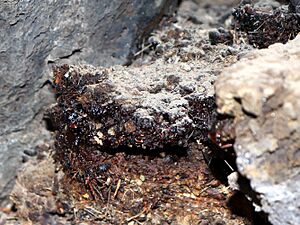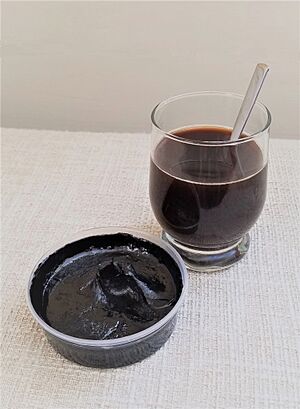Shilajit facts for kids
Shilajit (Sanskrit: शिलाजीत; meaning 'conqueror of mountains' or 'conqueror of rocks'), also called salajeet or mumijo, is a natural substance found in mountains. It is a blackish-brown powder or a sticky material that oozes from cracks in high mountain rocks.
You can find shilajit in places like the Himalayas, the Pamir Mountains, and the Altai Mountains. It's also found in countries such as Afghanistan, Pakistan, Nepal, Bhutan, Russia, Iran, Mongolia, and even in southern Peru.
People in Eastern cultures have used shilajit in traditional medicine for a very long time. It's used in systems like Ayurveda and Tibetan medicine. Shilajit is sold as a dry powder or in dietary supplements. However, it's important to know that there is no strong scientific proof that shilajit helps human health.
Contents
A Look Back in Time
Shilajit has been a part of traditional medicine for thousands of years. People in Afghanistan, India, Iran, China, Pakistan, Nepal, Central Asia, and Tibet have used it. Ancient thinkers like Aristotle and Avicenna wrote about its uses for different health problems.
In 1821, a writer named D'Herbelot mentioned that people in Persia used a substance called mumiay. They believed it was a powerful cure-all that could help with broken bones and diseases.
Where Shilajit is Found
Shilajit deposits are found in many mountain areas around the world. Even though it's found in many places, it's quite rare. The amount of raw shilajit available is limited.
It is often found in different types of rocks, including limestone and sedimentary rocks. You can find it in Central Asia, near Lake Baikal, in the Caucasus Mountains, and in the Himalayas. It's also common in the Tibetan Plateau and the mountains of the Arabian Peninsula.
Shilajit has many different names depending on the region. For example, it's called Salajeet in Pakistan and mumiyo in Russia. In Mongolia, it's known as brag-shun, which means "oil of the mountains." In Tibet, it's called "rock sap" or "rock juice."
How Shilajit Forms
Scientists have different ideas about how shilajit forms. One idea is that it comes from the breakdown of oil rocks by tiny living things called microorganisms. The chemical makeup of shilajit, which has a lot of carbon and hydrogen, supports this idea.
Another theory is that shilajit comes from plants. It might be the result of a very slow breakdown of plant material over hundreds of years. Some researchers think it forms from the decomposition of sticky plant materials like latex and resin from certain plants, such as Euphorbia royleana.
What Shilajit is Made Of
Shilajit is often called a mineral tar or resin, but it's actually neither. It looks like a thick, dark brown or black tar. However, unlike tar, it easily dissolves in water but not in alcohol.
Shilajit contains more than 20 different elements. These include important minerals like calcium, magnesium, sodium, and iron. It also has solid hydrocarbons, proteins, carbohydrates, amino acids, and fatty acids. About 15–20% of shilajit is made of minerals, plus tiny amounts of other elements like selenium.
It is also rich in many other helpful substances. These include mineral salts, more amino acids, and other natural compounds. A large part of shilajit, about 60–80%, is made up of substances called humic and fulvic acids.
When shilajit samples from different mountains like the Himalayas and Altai Mountains are studied, they show two main parts. One part is similar to fulvic acids found in peat. The other part contains various natural compounds from plants and animals.
Health Effects
Even though shilajit is used in traditional medicine, there is no good scientific proof that it has any helpful effects on human health.
Different Kinds of Shilajit
Shilajit can look different depending on where it comes from and how it formed.
- Coprolitic shilajit is made of fossilized plant and animal remains mixed with rock and soil.
- Shilajit-bearing breccias are rocks cemented together by a shilajit-rich clay.
- Evaporite shilajit forms as thin, shiny black or gray films on cave walls and roofs. It can be hard to collect.
Shilajit also comes in different colors and grades, depending on the type of metal it contains:
- Red shilajit (sauvarna shilajit) has gold.
- White shilajit (rajat shilajit) has silver.
- Blue shilajit (tamra shilajit) has copper.
- Black shilajit (lauha shilajit) has iron.
Black shilajit that contains gold is the rarest and is thought to have the best healing effects. However, in traditional medicine, the black shilajit containing iron is used the most.
There are also other natural substances that look like shilajit, called mumioids. These include things like ozokerite (a type of mineral wax) and fossilized plant resins.
See also
 In Spanish: Shilajit para niños
In Spanish: Shilajit para niños



